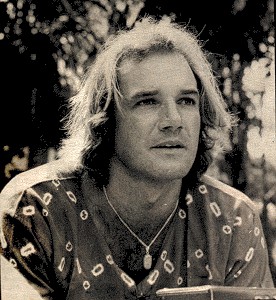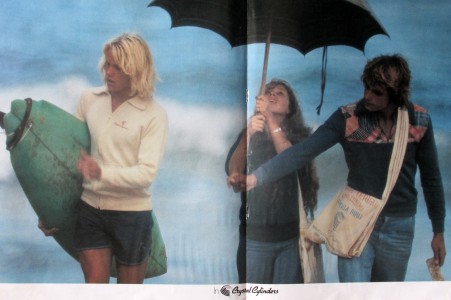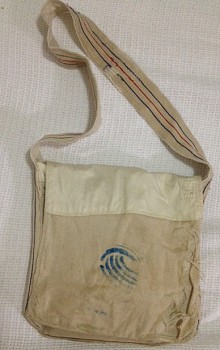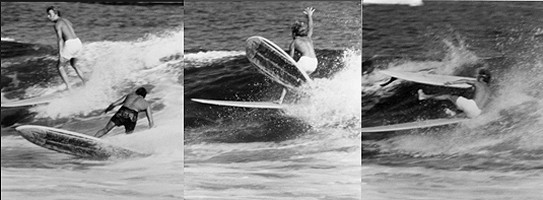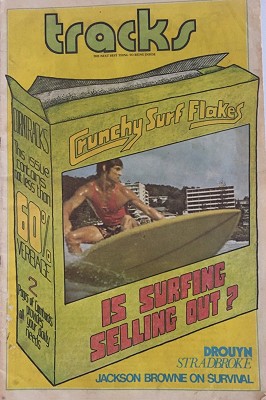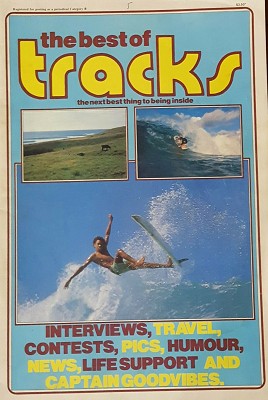You want the surfers in this contest to be human.
Yeah, exactly.
Until we have some sort of contact in surfing
contests it's going to be the same thing year
after year.
It's stagnated even though the prize money is bigger
these days.
Sponsors don't really see the value in surfing
contests.
They just see the value in selling their goods to
young people.
Tennis sponsors like tennis.
In surfing the sponsors think surfing contests are
ridiculous, they don't understand.
A guy can actually whip a guy off the wave, beat him
up, come onto the beach and have a fight if you
like.
That's okay.
We won't give any bonus points for it, but the
important thing is that they can beat each other up.
This is the sort of contact that can be done along
rhythmic lines.
Like Ali dancing
round his opponent for the entire first round or
Arthur Ashe throwing his racquet over net.
Yeah.
Ali might dance around the ring for the first two
minutes but there must eventually be physical
contact for a win.
There's got to be a blow thrown.
Now if they wanted to those boxers could dance for
15 rounds without throwing a punch and gonna win?
But surely you're not suggesting surfing is
a real contact sport?
Phil, it can be.
I feel it's the only way surfing is going to reach
into big money in competition.
Contact, both physically and mentally like boxing.
A blow must be thrown.
Surfing's the same.
I mean I could dance around a ring showing my style
and my aggression and what's the judge going say?
Oh, he's got a lot of style.
He would have done well if there's a fight.
There must be contact in surfing.
You've discussed this with a lot of pro surfers
around the world over past few months.
What do they think of it?
Let it be known that every surfer I've talked to has
been for it, simply because there's no other way to
turn.
They realise there's gotta be a radical change and
the time is right for it.
They've all expressed this to you?
I'm sure they have, in many erent ways.
In silent ways, in loud ways, in overtones and
undertones.
Do you expect much
out-of-the-water aggro or psyching out?
Obviously.
A lot of surfers won't want to come into contact so
they be trying to psyche the other guy out to avoid
it.
You might get a situation where Col Smith will be
Joe Frazier.
He'll want to rip and tear and cheat as much as
possible to win.
Midget, on the other hand, might dance.
He'd be Ali and he'll want to avoid contact, to win
his way.
I'm sure Midget'll dance.
Which surfers will benefit most from this system?
I don't think there's any particular surfer who'll
benefit more than the rest.
The ability will be brought out in all surfers, the
ability to think and outsmart.
That might sound like it's for university students
but it's not.
It's the board under your feet that's your brain.
It's all part of talent and ability.
But there must be some surfers who function
better in crowds than others and who'll
be ready for contact.
Sure.
The underdogs, the people who aren't written up in
magazines and featured in the movies.
The people who have been thrown out of game because
they have that ability to outsmart.
Who? Name names.
I reckon a guy like Bob McTavish could surf well
under this system.
Russell Hughes or Ben Aipa.
Dora maybe.
Of the current stars maybe Terry Richardson, Nat,
Midget.
There are a lot of young surfers around who are
being wiped out because of their flair.
Were you pleased when the Bells organisers
decided to adopt your system in part?
Absolutely stoked.
Do you think other contests will follow suit?
I really hope so.
I'm not in it for my own piece of the action.
I'd rather turn into obscurity.
I'm doing it for surfing.
I'm doing it for a lot of good surfers that even you
don't know about.
I'm doing it for the public.
I'm doing it for the good people in surfing who want
to buy houses and blocks of land and get into
businesses and get knocked back by governments and
police because they've got board racks on top of the
car.
My aim stretches so far for the good of young people
generally and surfers in particular that there's not
enough time for Peter Drouyn.
What will you do
if the system fails?
In the past I've tended to be over-optimistic about
things and I've been let down something bloody
shocking.
I'm taking a neutral approach with this contest; if
it doesn't work Drouyn bows out for another year,
but hell be back.
You'll hear from me again.
-
Phil Jarratt
|
Page 19
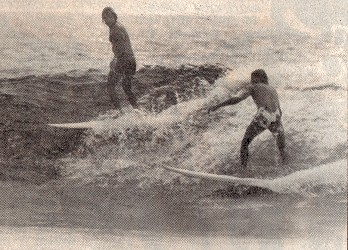
1. First you drop in on your
opponent ...
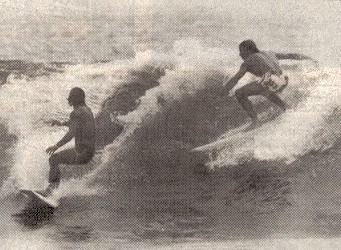
2. ... then you cut right
around him ...
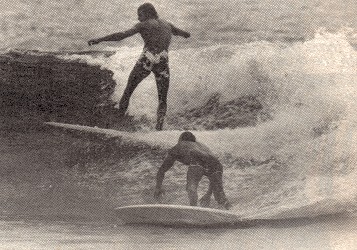
3. ... and turn hard on his
heels ....
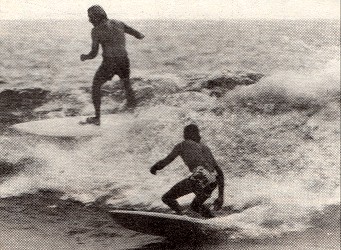
4. ... back at the top with
this much to spare ..
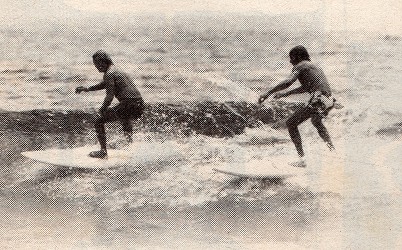
5.
... and you're in front of him again ..
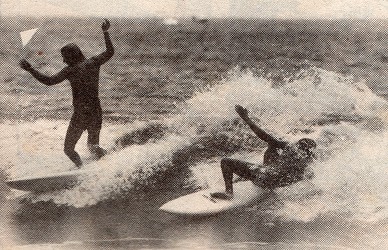
6. ... and you've psyched him
out, you've effectively cheated.
|


